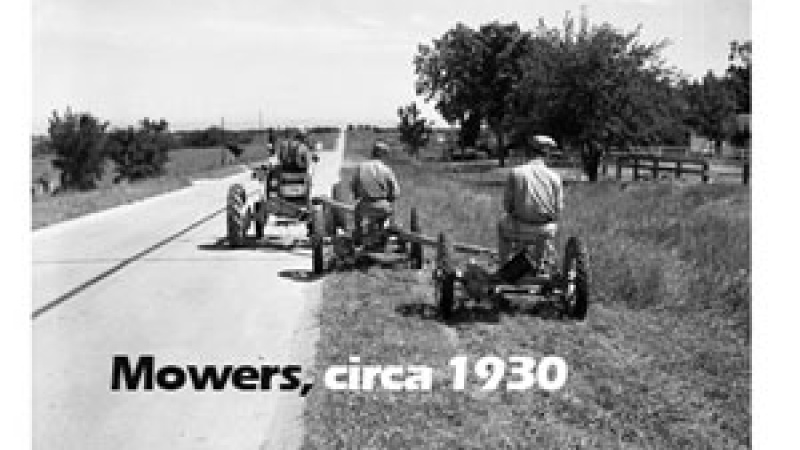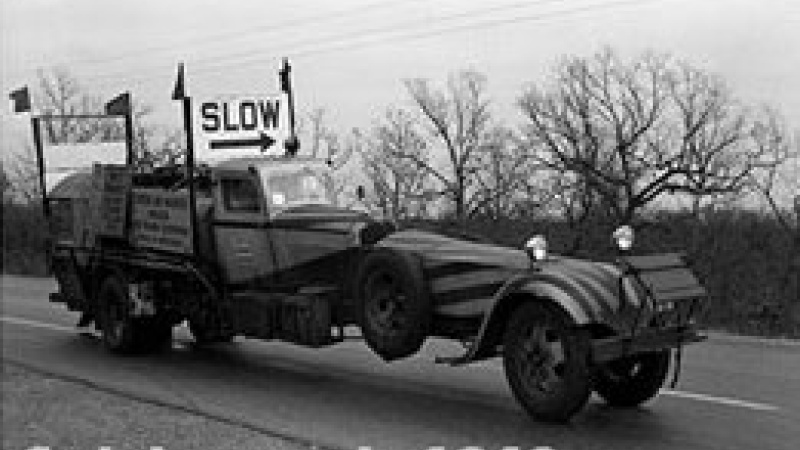Celebrating a Century
On March 22, 1913, the Missouri Legislature created the Missouri Highway Department. Almost immediately afterwards, construction began across the state to link adjoining county seats with paved and maintained roadways.
By the beginning of the next decade, Legislatures were trying to "get Missouri out of the mud" realizing that economic prosperity and growth were integrally tied to transportation.
Over the decades MoDOT has managed to keep Missouri moving. Today the state serves as a transportation crossroads for the entire nation.
There are 4,800 miles of railroad tracks, 1,379 miles of Interstates, 125 public-use airports and 15 public ports. If you're trying to get goods from one side of the country to the other, it's likely they'll pass them through Missouri.
It's safe to say that the Show-Me state will retain its position as the crossroads of the United States, and MoDOT will be here for another 100 years, leading the nation in innovation, efficiency and customer service.
Key Events in MoDOT's History
1913
Missouri Legislature forms State Highway Department.
1916
Congress passes federal highway act, which makes federal funds available to states based on area, population and postal road mileage.
1917
Missouri Legislature passes Hawes Law so Missouri can receive federal funds and also creates State Road Fund and a four-member State Highway Board.
1918
State Highway department produces one of the earliest Missouri road maps. (See more old Missouri maps on the maps archive page.)
1920
$60 million bond issue passes to "get Missouri out of the mud."
1921
Formal department operations are established when the Legislature passes the Centennial Road Law, creating a four-member State Highway Commission and the positions of secretary, chief engineer and chief counsel.
1924
Proposition 5 passes, creating the state's first fuel tax, 2-cents per gallon.
1928
Missouri becomes the first state to earmark and protect funds for highway purposes.
1931
State Highway Patrol is created.
1937
Missouri Legislature makes it "unlawful" to drive any motor vehicle on any highway of the state without either an operator's or chauffeur's license.
1952
Fuel tax increases to 3 cents per gallon.
1952
Department takes over responsibility for almost 12,000 miles of county highways, bringing 95 percent of all Missourians to within two miles of a hard-surfaced road.
1956
Missouri becomes first state in the nation to take bids and begin construction on the interstate highway system.
1961
Fuel tax increases to 5 cents per gallon; County Aid Road Trust (CART) Fund created.
1965
The commission's membership is increased by the Legislature from four to six members.
1972
Fuel tax increases to 7 cents per gallon.
1974
Missouri State Department of Transportation created.
1980
Missouri Highway Department and Transportation Department merge creating the Missouri Highway and Transportation Department.
1987
Proposition A passes and increases motor fuel tax by 4 cents per gallon.
1992
A 6-cent per gallon motor fuel tax is passed by the Legislature, to be phased in over a five-year period.
1994
The department commits to the Short-Term Action Plan to complete priority projects within a four-year period.
1996
Legislation passes stating the department shall be known as the Missouri Department of Transportation.
1998
Accountability legislation passes requiring MoDOT to submit an annual report to the legislature by November 10 and creating the position of MoDOT director.
1999
Department adopts a rolling 5-year plan for highway and bridge improvements in the state. The 15-Year Plan is no longer used by MoDOT as the financial blueprint for construction projects.
2000
Legislation was passed, effective May 30, 2000, allowing MoDOT to issue $2.25 billion in bond financing to accelerate highway improvements.
2002
Legislation is passed extending the 6-cents-per-gallon motor-fuel tax, which was due to expire in 2008. Proposition B, an omnibus transportation bill that would have increased the motor-fuel tax by 4 cents per gallon and the general sales tax by 1/2 percent, is defeated by voters by a 3-to-1 margin.
2004
In November, Missouri voters approved Constitutional Amendment 3, which requires all revenues from the sale of motor vehicles come to MoDOT
A partnership of Missouri safety advocates, including law enforcement agencies, health care providers, courts, government agencies, advocacy groups, planning organizations, concerned citizens and others banded together to form the Missouri Coalition for Roadway Safety. They implemented a strategic highway safety plan titled Missouri's Blueprint for Safer Roadways and began the Arrive Alive campaign, setting a goal to reduce roadway fatalities to 1,000 or fewer by 2008.
2007
The year ends with a traffic fatality count of 992 -- meeting the first Missouri Coalition for Roadway Safety goal of 1,000 or fewer deaths by 2008.
2008
The Missouri Coalition for Roadway Safety sets a goal of 850 or fewer deaths by 2012.
The Missouri Highways and Transportation Commission approved the Safe & Sound Bridge Improvement Program to repair or replace 802 of Missouri's worst bridges in five years.
2010
The year ends with 821 traffic fatalities -- meeting the second MCRS goal two years early.
2011
Funding issues and other factors force a restructuring of the department. MoDOT moves from 10 districts to seven to consolidate and streamline operations.
2012
The Missouri Coalition for Roadway Safety sets a goal of 700 or fewer roadway fatalities by 2016 while working toward an ultimate goal of zero traffic fatalities.
A survey of Missouri residents results in an 85 percent customer satisfaction rating for MoDOT.
2017
MoDOT launches the Buckle Up Phone Down campaign to address two critical issues: unbuckled fatalities and distracted driving crashes.
2019
From April 29 through June 14, MoDOT closes more than 114 roads in the state due to flooding.
Missouri receives an $81.2 million Infrastructure for Rebuilding grant from the U.S. Department of Transportation to build Missouri River Bridge at Rocheport. Receipt of the grant triggers bonding, authorized by the Missouri General Assembly to repair or replace another 250 bridges across the state.
2020
Many MoDOT employees moved their operations to their homes to prevent the spread of COVID-19. MoDOT also dealt with a significant decrease of revenue due to less driving amidst stay-at-home orders and mandates. Despite setbacks, MoDOT delivered a record construction program.
2021
Missouri Highway and Transportation Commission celebrates its 100th year serving Missouri.



